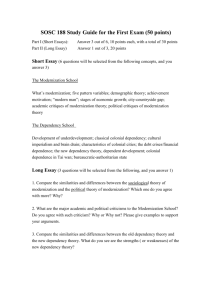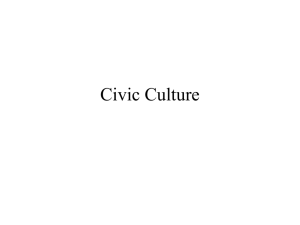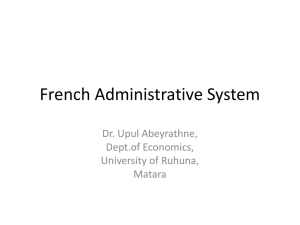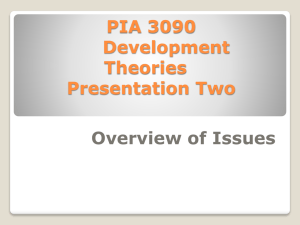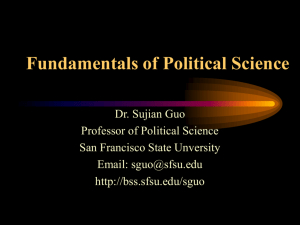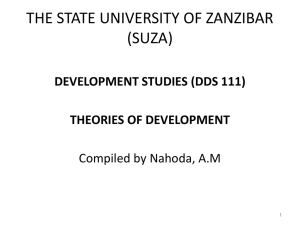Dependency Theory
advertisement
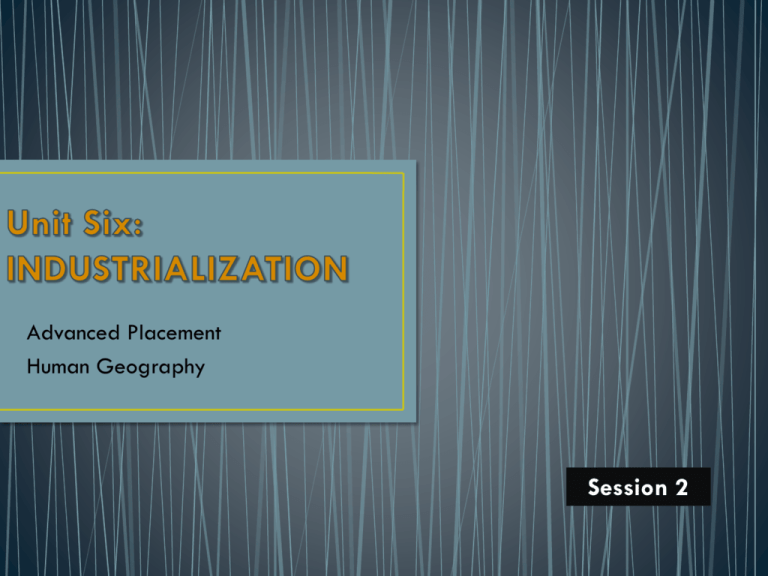
Advanced Placement Human Geography Session 2 • Two conflicting theories have guided social scientists in the 20th century in answering the question. • Those theories are: • THE MODERNIZATION MODEL AND • DEPENDENCY THEORY • According to this theory, Britain was the FIRST country to begin to develop its industry. • The Industrial Revolution was spurred by a combination of: • prosperity • trade connections • inventions • natural resources • Max Weber asserted that Western Europe had a cultural environment that favored change. • The growing importance of individualism steadily replaced the traditional emphasis on community. • The British model spread to other European nations and the U.S., which prospered because they built on British ingenuity and economic practices. • By extension, any country that wants to improve its economy should follow the British model and enjoy modernization, or “westernization.” • Modernization theory identifies tradition as the greatest barrier to economic development. • In societies with strong family systems and a reverence for the past, the culture discourages people from adopting new technologies. • As a result, standards of living are not raised. • Dependency theory puts the primary responsibility for global poverty on rich nations. • The theory also holds that economic development is blocked by industrialized nations that exploit the poor countries. A favela in Rio de Janeiro How can a country develop when its natural and human resources are controlled by a handful of prosperous industrialized countries? Inequality has its roots in the colonial era when European nations exploited resources in various parts of the world. • Although many countries gained independence in the 20th century, they have not gained economic wealth. • This theory is an outgrowth of Marxism, which emphasizes exploitation of one social class of the other. • Many LDCs have experimented with various forms of socialism. • Their intent is to nationalize industry and narrow the gap between rich and poor. Modernization Theory holds that economic prosperity is open to all countries. According to W.W. Rostow, modernization occurs in four stages. • People in traditional societies build their lives around: Stage One • families • local communities • religious beliefs • Wealth is generally limited. • Most people are subsistence farmers. Stage Two • Political leaders encourage people to produce goods for their own consumption AND for trade. • Sustained growth takes hold. • Urbanization increases. Stage Two • Technological and production breakthroughs occur. • Individualism flourishes, often at the expense of families and traditional customs. Stage Three • Economic growth is widely accepted. • People focus on higher living standards and can afford more luxuries. • Poverty is reduced and material goods are much more common. • Cities grow as more people leave farms. • Modernization is evident in the country’s core. • Population growth decreases. • International trade expands. Stage Three Stage Four • Economic development raises living standards. • Mass production encourages consumption of industrial products. • Items that have been luxuries in earlier stages of development now become necessities (e.g. automobiles). Stage Four • This stage is marked by high incomes. • A majority of the workers are involved in the tertiary (service) sector of the economy. • This theory claims that high-income countries can help poorer countries by encouraging them to: • control population growth • increase food production • take advantage of industrial technology High income countries also help poorer countries with foreign aid. • Socialist countries believe that modernization theory provides justification for capitalist systems to continue to exploit non-capitalist countries. • Others believe that modernization simply cannot occur in many poor countries. • Critics also assert that rich nations, which benefit from the status quo, often block paths to development for poor countries. • Another criticism is that the theory suggests that the causes of poverty lie in the poor countries themselves, which means that it blames victims for their own plight. • In 1974, Wallerstein explained economic development using a model of the capitalist world economy, a global economic system that is based on high-income nations with market economies. • He traced economic inequality among nations to the colonial era when Europeans first took advantage of the rest of the world. • Wallerstein divided today’s countries into three types, according to how they fit into the global economy: • Core countries • Countries of the periphery • Countries of the semiperiphery • This category includes the rich countries of the world that fuel the global economy by taking raw materials and channeling wealth, through multinational corporations, to: • North America • Europe • Australia • Japan • This category includes lowincome countries that were exploited during the colonial era. • These countries continue to support rich countries today by providing inexpensive labor. • Countries of the periphery are also a large market for industrial products. • The remaining countries of the world have characteristics that place them somewhere between the core and the periphery. • Countries of the semiperiphery exert more power than peripheral countries but are dominated to some extent by the core. • The world economy benefits rich societies and harms other countries by making them dependent on the core. • Dependency is perpetuated by narrow, export-oriented products such as oil, coffee, and fruit. • Poorer countries lack industrial capacity so they are caught in a cycle of selling inexpensive raw materials and buying expensive manufactured goods. • As a result, foreign debt cripples poorer countries even further. Dependency theory emphasizes the idea that NO COUNTRY develops in isolation because the global economy shapes the destiny of all nations. • Critics disagree that wealth is a zero-sum commodity, as if no one gets richer without someone getting poorer. • They believe that new wealth is created through: • ambition • hard work • new uses of technology • Critics also believe that the theory places blame on rich countries that have a long history of supporting economies of nations such as: • India • South Korea • Japan • The poorer countries have been supported through foreign investments that foster economic growth. • Dependency theorists are also criticized for ignoring cultural factors in poor countries that discourage economic growth. • Corrupt leaders may contribute to poor economic health in a country that lacks a strong rule of law, since the country’s wealth is monopolized by the elite. This model encourages LDCs to isolate newer businesses from competition from large international corporations. How can LDCs escape global inequalities? The government can: • Shield local businesses from trade in international markets • Encourage internal growth • Limit imports from other places Another approach to protecting local markets: • Require international companies to purchase expensive licenses that discourage them from selling within the newly industrialized country’s borders. Example: India • India has used all of the methods described to encourage internal economic development. • However, problems persisted. Problems in India • Inefficiency • Little incentive for businesses in India to develop better products • Complex bureaucracy that hampered development • • • • • • • • • Modernization Model Dependency Theory Industrial Revolution Individualism Westernization Modernization Marxism Socialism Sustained growth • • • • • • • • Mass consumption Core Semiperiphery Periphery Status quo Foreign debt Foreign investments Self sufficiency theory
